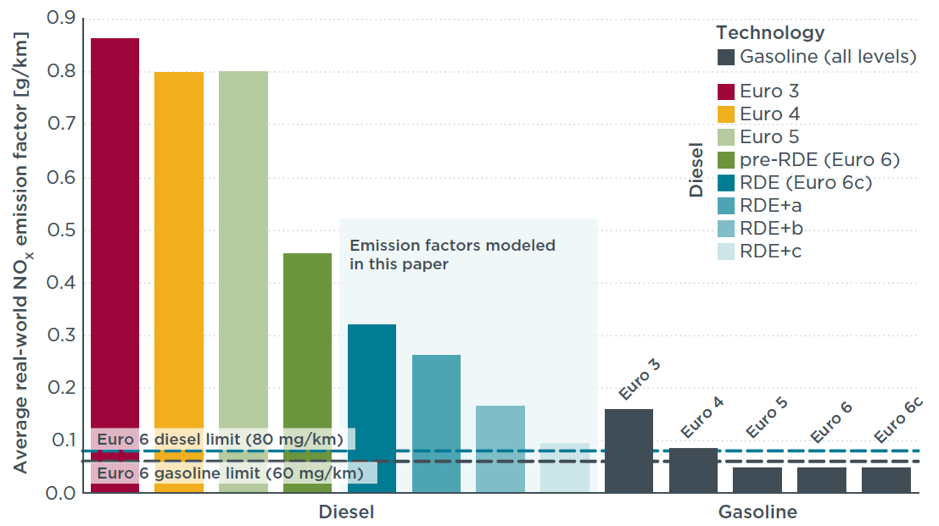Press release
[Press release] New Real-Driving Emissions regulation: A great step forward—though not yet far enough to fully control toxic nitrogen oxide emissions
Real-world NOx emissions from new diesel cars could still exceed the Euro 6 emission limit of 80 mg/km by a factor of three or more, even after the new RDE regulation takes effect, according to research released today by the International Council on Clean Transportation. But taking specific actions beyond those mandated in the regulation, such as introducing spot checks for randomly selected vehicles and expanding the range of driving conditions covered by RDE testing, could reduce new diesel car NOx emissions to 96 mg/km—just 1.2 times the Euro 6 limit—by 2022. These findings come while the European Commission and EU member states discuss further development of the RDE regulation.
Since September 2015, all new diesel cars in the EU are required by the Euro 6 standard to meet a NOx emission limit of 80 mg/km. However, investigations in the aftermath of “Dieselgate,” for example by the German type-approval agency KBA, have confirmed that the majority of current vehicles meet the Euro 6 NOx limit only during laboratory testing. On-road emissions are much higher—about 5–7 times the Euro 6 limit (400–560 mg/km), on average. Beginning in September 2017, the Real-Driving Emissions (RDE) regulation will require that diesel cars also undergo emissions testing while driving on the road. NOx emission levels during RDE testing will be limited to a maximum of 2.1 times the Euro 6 limit (168 mg/km) until September 2019, when the RDE emissions limit will be lowered to 1.5 times the Euro 6 limit (120 mg/km).
However, the RDE regulation needs to be further developed to meet those limits. “Unlike the name suggests, the RDE regulation does not fully cover the real-driving conditions of normal vehicles,” says Dr. Peter Mock, Managing Director of ICCT in Europe. “This is because a number of driving situations, such as driving at unusually cold or hot temperatures or driving at higher speeds, are still excluded in the current version of RDE testing. Also, vehicle manufacturers can decide which vehicle to test—typically a carefully prepared prototype version. They can carry out the testing themselves and thereby optimize the results.”
Vehicles with defeat devices installed have an especially large impact on average NOx emission levels. “The RDE regulation is an important step in the right direction,” says Joshua Miller, ICCT researcher and one of the authors of the study, which analyzed an extensive set of diesel car emissions data using modeling of the boundary conditions of the RDE regulation. “But the current version of RDE is not designed to detect defeat devices, and without further provisions to test in-service vehicles rather than prototypes and to expand the range of driving conditions covered by the test, resulting real-world emission levels will be higher than the adopted RDE emission limits suggest.”
The European Commission, against resistance of some vehicle manufacturers and EU member states, is planning to introduce regular spot checks for randomly selected vehicles and force governments to impose financial penalties and recalls if on-road emissions are found to be too high. The issue will be brought forward for discussion as part of a working group meeting on January 17 in Brussels.
Although the planned move by the European Commission is welcome, a realistic view is needed with respect to timing. “Even in our most optimistic scenario, with a substantial improvement in NOx technology applications and enforcement practices, we expect the average real-world NOx emissions level of new diesel cars to drop to 96 mg/km only in 2022,” says Miller. “This highlights the need for further tightening vehicle emissions testing procedures. Otherwise, diesel car NOx emissions will remain above the regulatory limit for many years to come, and at levels much higher than those of gasoline cars.”
The analysis also shows that at the local level, a 50% reduction in NOx emissions could occur 8 years sooner via introduction of a low-emission zone that progressively excludes older diesel cars from entering the city center.
Impact of improved regulation of real-world NOx emissions from diesel passenger cars in the EU, 2015–2030 (PDF download)
Contact: Dr. Peter Mock, Managing Director ICCT Europe, +49 (30) 847129-102, peter@theicct.org
